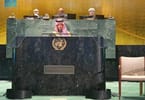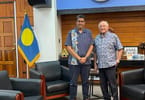Arusha, Tanzania ((eTN) – The entire Tanzania’s Northern safari capital of Arusha went into standstill on Monday as US President George Bush, made scene in town.
On his second day in Tanzania, Bush moved from the Indian Ocean port of Dar es Salaam to the northern highlands of Arusha, an area known as a cradle of African safari adventure.
With only one main road part of which was forced into closure for hours, local motorists opted to ground their vehicles causing a major transport blues.
Most of business centers remained closed because majority of workers could not afford to make it to workplaces as all town commuter vans and taxi-cabs were ceased to operate as early as 7:00 am to pave the way for Bush’s entourage.
Last time such a situation witnessed in Arusha in August 2000 when the immediate retired US president visited the town to witness the Burundi peace accord signing ceremony.
During the Clinton’s brief visit which lasted not more than 12 hours the ‘whole world’ came at a standstill until such time when a leader of the most democratic and strongest nation in the world went away
This time around, crowds of people could be seen lining up on either sides of Arusha-Moshi road all the way from Philips to Mianzini suburb and along Namanga road from Col. Middleton road junction to the Sakina-TCA crossroads.
Others lined up from Kambi-ya-Fisi suburb, along Nairobi road to Ngarenaro villa corner, then onto Mbauda-Majengo along Dodoma road.
The section Dodoma road from the so called Nairobi corner all the way to Makuyuni area at the border of Arusha and Manyara regions was put into no go zone.
Majority of Arusha residents apparently believed that President George W. Bush would greet them by holding their hands as it was the case in Dar-es-salaam, but their hopes turned into nightmares when the American state motorcade simply speed past them as local police officers pushed them back.
There was a sudden scarcity of fresh milk in town since hawkers who normally bring the commodity to town, from Arumeru hills could not find their way to town since their bicycles were refused to cross the road with huge, mysterious looking containers.
With the 45 kilometers road stretch from Kilimanjaro Airport to Arusha town closed, newspapers could not get to town in time and the hunger for news especially about Bush himself, intensified.
It was until about 2.00 pm that the papers reached town, add another hour for distribution and people here got their newspapers in the evening.
An agent of Kilimanjaro Express Bus services, Victoria Obeid says the US President Bush visit in Arusha forced them to cancel a single bus trip to Dar-es-salaam as the highway was placed under siege as early as 8:00 AM.
Kilimanjaro Express is among nearly 40 passenger buses plying between Dar and Arusha everyday and over 300 minibuses ferrying passengers between Arusha and Moshi townships that were affected by the US president’s visit.
The security measures also never spared Tour operators as they have to abide by the no go zone declaration.
Only scheduled airlines were allowed to land at between 10:00-18:00 hrs, according to an e-mail message from the Tanzania Tour Operators Association Executive Secretary Mustafa Akuunay circulated to all tour operators.
Within radius of 60km from Arusha Airport some 8km west of Arusha town, no training, Aerobatics, Hand Gliders, Hot Air Balloons parachuting, and Flights etc were allowed.
The road from Kilimanjaro International Airport (KIA) via Mianzani, corner of Nairobi road, down to Tanzania National Parks Authority Headquarters, Arusha Airport to A to Z Textile Mills factory in Kisongo was closed between 8.00 -15.00 hrs.
Bush landed here, in sight of the majestic Mount Kilimanjaro, and was greeted by Massai women dancers who wore purple robes and white discs around their necks. The president joined their line and enjoyed himself, but held off on dancing.
His theme is the prevention of malaria, a parasitic disease that is particularly lethal to young children and pregnant women.
Bush and first lady Laura Bush began the day touring a hospital and later visited a textile mill that makes mosquito bed nets of A to Z.
Olyset, a long-lasting insecticidal net (LLIN), is a crucial tool in the fight against malaria – and the only WHO-recommended LLIN manufactured in Africa, where a child dies from malaria every 30 seconds.
The Arusha net factory is a 50/50 joint venture between Sumitomo Chemical, a multi-national Japanese company headquartered in Tokyo, and A to Z Textile Mills, an Arusha based Tanzanian company.
The joint venture legal entity, ‘Vector Health International,’ is an expansion of a business relationship that commenced with a royalty-free technology transfer in 2003. The new facilities bring Olyset production capacity in Arusha to 10 million nets per year.
Over 3,200 jobs have been created in the venture, supporting at least 20,000 people.
“We are delighted to celebrate with all of you this significant milestone. Our collaboration has grown to a full-fledged joint venture.” said Hiromasa Yonekura, President of Sumitomo Chemical during the official inauguration of the factory.
LLINs are proven, effective tools in the fight against malaria. Olyset Net was the first LLIN to be submitted to the World Health Organization’s Pesticide Evaluation Scheme (WHOPES) and remains the only LLIN to have passed all four stages of the evaluation process confirming efficacy and longevity.
The Olyset Net is tough, durable and wash-proof. Insecticide is incorporated within the net’s fibers during manufacture, for slow release over a sustained period of time.
Consequently, they never need re-treatment with insecticide, and are guaranteed to be effective for a minimum of five years.
In field tests, Olyset nets have been shown to still be effective after seven years in Tanzania. “Africa needs direct foreign investment to build strong economies, and when 90 percent of the malaria deaths are in Africa, why should we have to import bed-nets?” Wondered Anuj Shah, CEO of A to Z Textile Mills.
“These jobs are transforming our community, and we are seeing that children are staying in school longer as one immediate result.”
At least two children aged five years and below, die every minute from Malaria in Africa. The disease tops medical cases in Arusha in each passing day.
A to Z Textile Mills Ltd., was established by the Shah family in 1966 in Arusha, Tanzania as a small garment manufacturer. In 1978, the company started manufacturing polyester bed-nets.
Bed-nets now constitute a large percentage of production, taking place in fully integrated plants with spinning, knitting, weaving, dyeing, finishing, cutting and making departments.
WHAT TO TAKE AWAY FROM THIS ARTICLE:
- An agent of Kilimanjaro Express Bus services, Victoria Obeid says the US President Bush visit in Arusha forced them to cancel a single bus trip to Dar-es-salaam as the highway was placed under siege as early as 8.
- On his second day in Tanzania, Bush moved from the Indian Ocean port of Dar es Salaam to the northern highlands of Arusha, an area known as a cradle of African safari adventure.
- There was a sudden scarcity of fresh milk in town since hawkers who normally bring the commodity to town, from Arumeru hills could not find their way to town since their bicycles were refused to cross the road with huge, mysterious looking containers.






















